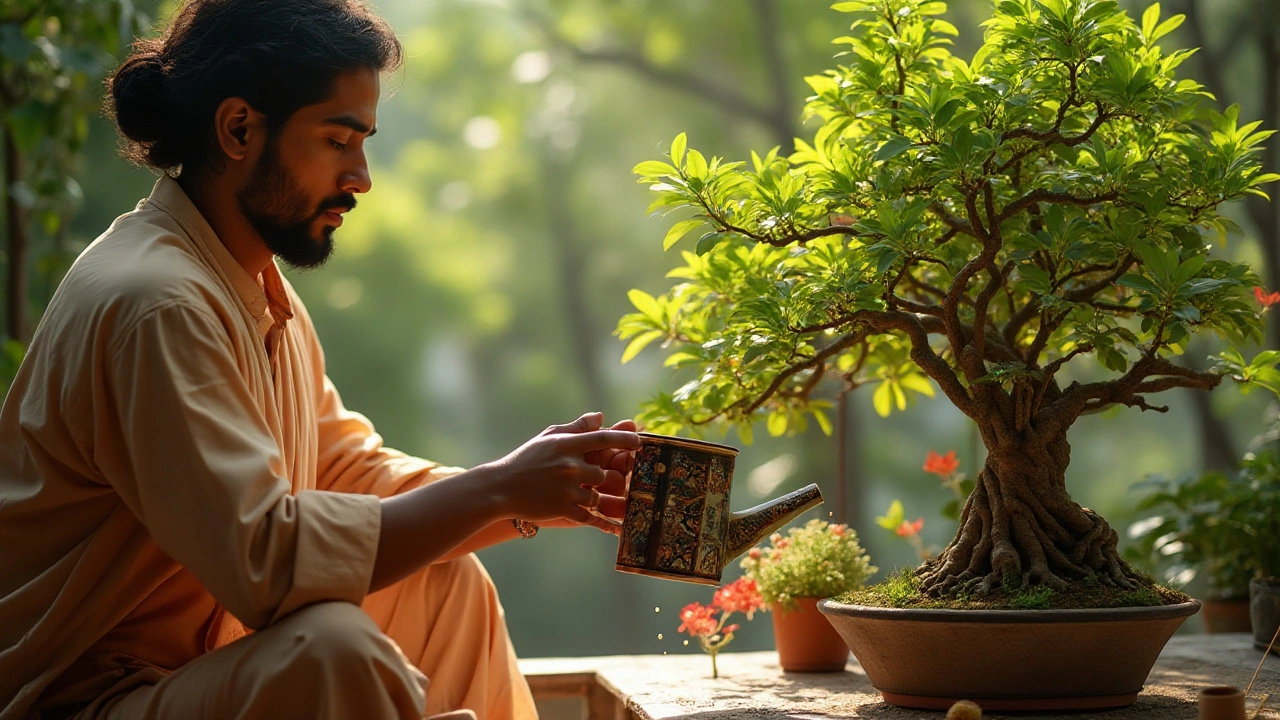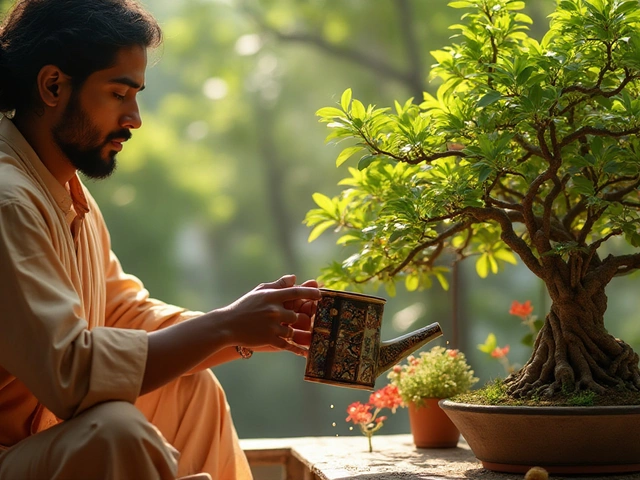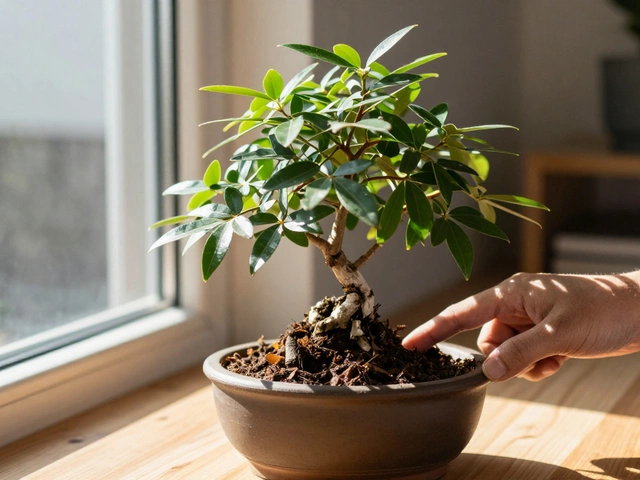Caring for a bonsai tree can be an enriching journey, connecting you closely with nature. One of the most critical aspects of bonsai care is understanding how often to water these delicate trees. Unlike regular houseplants, bonsais have unique requirements that depend on several variables.
Grasping these elements is crucial to maintaining their health, ensuring that they grow beautifully and harmoniously. Whether you're a budding bonsai enthusiast or have cultivated these miniature masterpieces for years, striking the right balance in your watering routine can make all the difference.
- The Basics of Bonsai Watering
- Factors Affecting Watering Frequency
- Signs Your Bonsai Needs Water
- Common Watering Mistakes
- Advanced Bonsai Watering Techniques
The Basics of Bonsai Watering
Watering a bonsai tree is not just about splashing the soil with water every once in a while; it requires a keen understanding of the tree’s needs and an ability to respond to changing conditions. Each bonsai species may require slightly different watering routines, but the underlying principle remains the same: maintaining optimal soil moisture without causing waterlogging. A bonsai's environment, including the climate, time of year, and location within your home, significantly affects how often it should be watered. Typically, the goal is to keep the soil around your bonsai consistently moist, akin to a damp sponge that isn't dripping wet. You should aim to water your bonsai thoroughly, ensuring that each root receives adequate hydration. Bonsai watering is both an art and a science, demanding intuition and adjustment to your specific tree's responses.
An essential step in the bonsai watering process is checking the soil moisture regularity. Insert a finger about an inch deep into the soil; if it feels dry, it's time to water. Sometimes, you might need to use other tools like moisture meters to ensure precision. Experienced enthusiasts recommend watering early in the morning or late afternoon, as it allows the tree to absorb moisture most effectively and prevents rapid evaporation. Another vital factor is water quality; using rainwater or tap water left standing overnight can be beneficial, as it ensures the water does not contain chemicals harmful to the bonsai.
"The key to successful bonsai is this: watch the tree with care, and let it teach you what it needs," suggests renowned bonsai expert John Naka, emphasizing the importance of observation and adaptation in bonsai care.
Let's delve into the different techniques. Some bonsai trees prefer the immersion method, where the pot is submerged in water until no more bubbles emerge, ensuring thorough saturation. Others respond better to a gentle overhead watering, simulating rainforest conditions. The type of pot your bonsai resides in—ceramic, plastic, or stone—can also affect the watering frequency due to differences in drainage and evaporation rates. Speaking of pots, the drain hole is crucial; an absence of effective drainage can lead to root rot, a common bane for budding enthusiasts. Bonsai maintenance entails vigilance, as these tiny trees can sometimes be temperamental. Learning to read the ancient language of leaves, stems, and soils can turn you into a botanical detective, solving the mysteries of your bonsai's needs.
Factors Affecting Watering Frequency
When nurturing a bonsai tree, it’s crucial to comprehend the variables that may alter its watering requirements. The species of your bonsai is undoubtedly a key player; each type has a unique need for water that can dramatically impact care routines. Certain species, like the juniper bonsai, often demand less water compared to the more tropical varieties such as the ficus. Understanding these distinctions is vital to tailor your watering practices appropriately.
Additionally, the climate in which you keep your bonsai plays a significant role. A bonsai residing in a humid environment may retain moisture longer than one placed in a dry or arid condition. Seasonal changes compound this, often requiring an adjustment of your watering frequency as shifts in humidity and temperature occur. If your bonsai is exposed to direct sunlight, evaporation rates climb, further necessitating more frequent watering. This calls for a keen eye on both the weather and your plant’s wellbeing.
Let's not overlook the container type, as it remarkably influences how often you should water your bonsai. The size and material of the pot determine water retention. Porous materials such as clay may wick moisture away more swiftly than glazed containers, impacting the duration intervals between watering. Optimal drainage is essential not only to prevent root rot but also to provide a balanced environment that mimics the tree's natural habitat. Bonsai tree care hinges on these subtle yet crucial decisions.
"Consistent attention to the bonsai's habitat and balance in watering is the secret to its flourishing," suggests Kenji Miura, a prominent master in the art of bonsai cultivation.
Another layer to consider involves the soil mix used in your bonsai pot. Often, the blend consists of akadama, pumice, and lava rock which influences moisture retention. The soil’s quality and structure play pivotal roles in determining how quickly water is absorbed and subsequently evaporated. Should the mix be denser or heavier, you may notice slower drying times, requiring less frequent watering. Conversely, those lighter and aerated may need a closer inspection and more attention to remain adequately watered.
Lastly, remember that each tree is individual, with its own unique characteristics not just by species but by personality as well. Observing your bonsai tree care techniques and how they correspond with your specific plant's feedback creates a deeper understanding of its needs. Constantly checking the feel and color of the soil, alongside regular observation, will hone your skill to achieve a perfect watering balance.
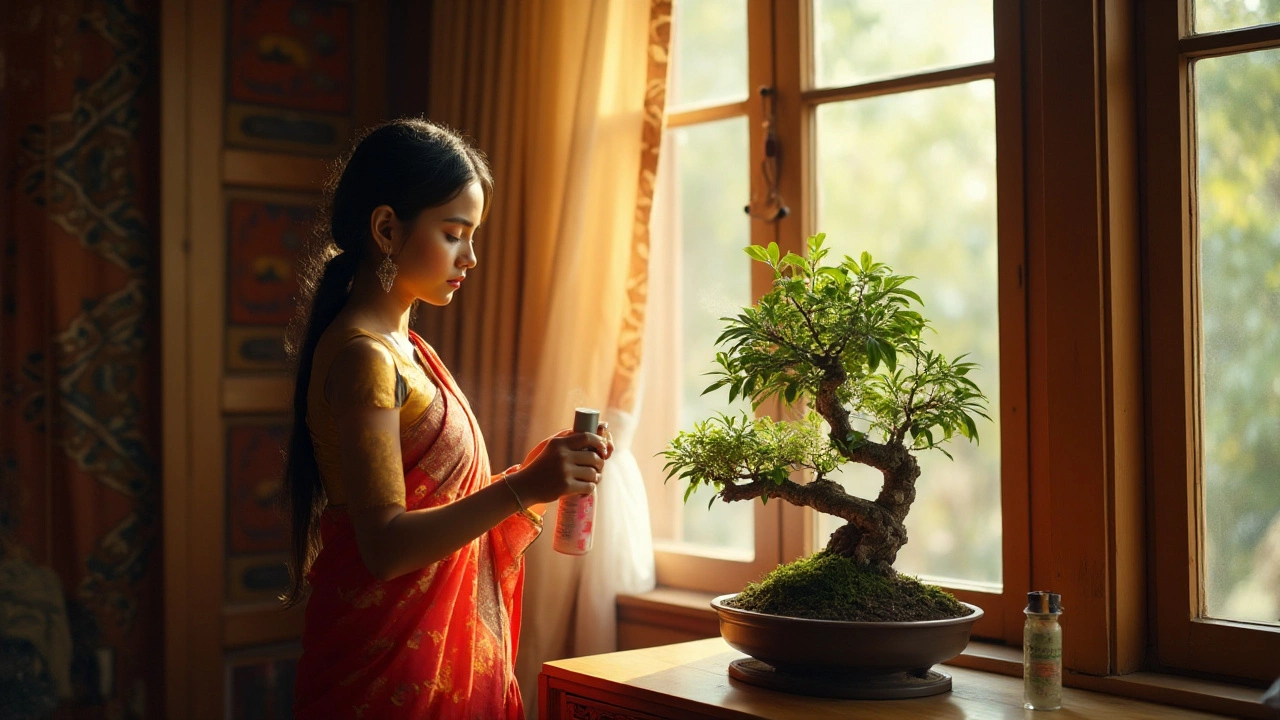
Signs Your Bonsai Needs Water
Observing the health of your bonsai requires a keen eye and a patient spirit. Understanding when to water is about recognizing the subtle cues that indicate your miniature tree's needs. One of the most direct ways to tell if your bonsai requires watering is by monitoring the soil condition. If the soil appears dry and crumbly to the touch, it’s usually a tell-tale sign that watering is needed. However, just skimming the surface might not provide all the answers, as the deeper soil might still hold moisture.
Another method to gauge the need for water is through the foliage's appearance. Healthy bonsai leaves should look vibrant and firm. When your bonsai lacks sufficient water, the leaves may begin to wilt or curl, losing their lustrous sheen. In more severe cases, they might turn yellow or brown, indicating distress and potential damage. It's essential, however, not to confuse signs of underwatering with symptoms of overwatering, which might manifest similarly.
"Understanding your plant isn’t just about following set rules. It’s about adapting to what it tells you," notes renowned horticulturist Lena Vanderbeek, emphasizing the importance of individual plant observation.
Weight is another indicator that can tell you when your bonsai requires water. By lifting the pot, you'll notice a significant change in weight from wet to dry soil. A bonsai pot that feels noticeably lighter could be ready for its next drink. This technique is particularly beneficial for those who have a routine of picking up their bonsai frequently and can feel subtle weight variances over time. It's a technique often suggested by seasoned bonsai enthusiasts for getting a 'feel' of the tree's moisture level.
Humidity levels play a large role in how frequently you need to water your bonsai. If you’re in a particularly dry climate, then your bonsai will likely need more frequent drinks than those in more humid areas. During different seasons, these humidity levels can fluctuate, impacting your regular watering schedule. It's important to adjust your habits in tune with the environment and the constant changes it undergoes.
Lastly, the bonsai species plays a huge role in its watering needs. Tropical species like the Ficus, for example, may require more frequent watering compared to temperate species like a Juniper. Always take time to know the specific needs of your bonsai’s species. This knowledge will empower you to care for your tree more effectively and understand its unique requirements.
Common Watering Mistakes
When it comes to watering your bonsai trees, even the most experienced enthusiast can make mistakes that may jeopardize the health of these intricate plants. One common pitfall is over-watering, which often happens due to the misconception that more water means better growth. In reality, excessive watering can lead to root rot, a condition where the soil remains too wet, depriving the roots of oxygen and causing them to decay. It’s crucial to strike a balance and allow the soil to dry out slightly between each watering session.
Conversely, under-watering is another frequent mistake. Bonsais can be particularly susceptible to drought-like conditions because of their shallow pots and reduced soil volume. This often leads to the soil drying out too fast, making it imperative to regularly check the soil moisture level by inserting a finger up to the first knuckle into the soil. If it feels dry at that depth, it's time to water. Quoting the Bonsai Society of America, “A bonsai must never completely dry out.”
Water hardness can also affect how well your bonsai tree grows. Hard water with high mineral content might accumulate on the soil surface, creating a crust that affects soil pH and plant health. Using rainwater, distilled water, or a water conditioning solution can help mitigate this issue. Additionally, watering time frame can make a difference. Early morning or late afternoon are optimal because the cooler temperatures prevent rapid evaporation, allowing water to penetrate deeply into the soil.
Improper watering techniques are among the less discussed errors. Simply pouring water over the top often results in uneven distribution, with some areas being too wet and others remaining dry. For even moisture, use a watering can with a fine rosette head to gently drizzle water to the root level. A popular technique is the immersion method for smaller bonsais, where the pot is submerged in water until it stops bubbling, ensuring the root ball receives adequate hydration.
Another mistake lies in not adjusting your watering schedule to accommodate seasonal and climatic changes. The required frequency can increase in summer due to high temperatures and reduce in winter when the tree’s growth rate slows. Adapting to the environment is key; a bonsai may need daily watering during dry, hot spells while only requiring weekly attention in cooler weather. A flexible schedule rather than a rigid routine is generally best for maintaining healthy bonsais.
Finally, understanding the specific needs of your bonsai species cannot be overstated. Each type has distinct requirements. For instance, a juniper bonsai might require less frequent watering compared to more water-loving species like the ficus. Researching and observing specific species' needs supports vibrant growth and reduces the risk of watering-related issues. Keeping a bonsai diary where you can track watering patterns, observations, and adjustments can greatly enhance your bonsai care routine.
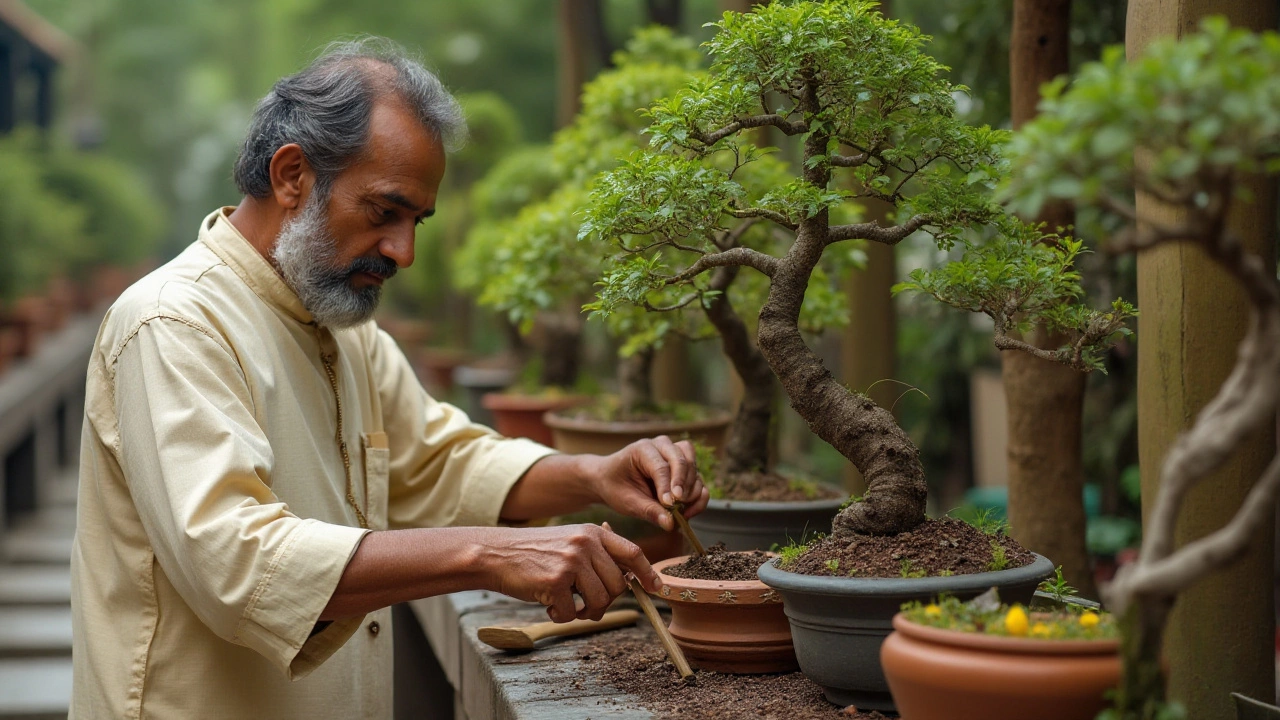
Advanced Bonsai Watering Techniques
Once the basics of bonsai watering are mastered, diving into advanced techniques can elevate your bonsai care practice. Starting with understanding water quality, the type of water you use plays a significant role. Rainwater, for instance, is often recommended due to its purity, as it lacks the chemicals typically found in tap water. Collecting and storing rainwater can provide a natural and beneficial hydration source for your bonsai tree care. If rainwater collection isn't feasible, consider filtering tap water to remove chlorine, chloramine, and other additives that may not be ideal for sensitive trees.
Another critical factor is the timing of your watering routine. Morning is generally the best time to water your bonsai. The roots have all day to absorb moisture, and any excess water has time to evaporate before nightfall, reducing the risk of root rot. It's interesting to note that different bonsai species may exhibit varied circadian rhythms, affecting water absorption rates at different times of the day. For bonsai enthusiasts dedicated to exploring these nuances, keeping a journal to track how different watering times impact your tree's health can offer valuable insights.
Incorporating humidity trays can significantly benefit your bonsai maintenance, especially during dry seasons or if you reside in an area with low ambient humidity. A humidity tray placed beneath the bonsai pot allows evaporating water to increase moisture around the tree, mimicking a natural forest floor environment. This technique can be particularly useful for bonsai tree care species like Azaleas or Maples, which originate from more humid habitats. Enhancing environmental humidity supports healthy growth and minimizes leaf drop, a common stress response in arid conditions.
For those keen on precision, investing in moisture meters can provide an edge in understanding the soil's moisture level. These tools offer accurate readings and help determine the precise time to water, avoiding both underwatering and overwatering, which are primary challenges for bonsai enthusiasts. According to renowned bonsai artist John Naka, "A bonsai—which ever tree—is meant to be the owner’s partner in shaping thoughts and daily life." Utilizing technology in the form of moisture meters can align with fostering deeper connections with your bonsai, allowing intuitive responses to the tree's needs.
Lastly, seasonal adjustments are crucial in advanced bonsai watering. During growth phases in spring and summer, your bonsai will naturally require more hydration. Conversely, in the dormancy stages during winter, water needs diminish. To aid in understanding these changes, some collectors track foliage color as an indicator of hydration efficiency, providing real-time feedback on whether watering techniques need adjustments. By rotating several advanced techniques, you can develop a dynamic approach that aligns consistently with your bonsai's evolving needs.
